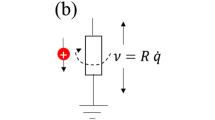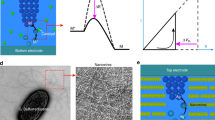Abstract
Memristors close the loop for I-V characteristics of the traditional, passive, semi-conductor devices. A memristor is a physical realisation of the material implication and thus is a universal logical element. Memristors are getting particular interest in the field of bioelectronics. Electrical properties of living substrates are not binary and there is nearly a continuous transitions from being non-memristive to mem-fractive (exhibiting a combination of passive memory) to ideally memristive. In laboratory experiments we show that living oyster mushrooms Pleurotus ostreatus exhibit mem-fractive properties. We offer a piece-wise polynomial approximation of the I-V behaviour of the oyster mushrooms.
Access this chapter
Tax calculation will be finalised at checkout
Purchases are for personal use only
Similar content being viewed by others
References
Chua, L.: Memristor-the missing circuit element. IEEE Trans. Circuit Theory 18(5), 507–519 (1971)
Abdelouahab, M.-S., Lozi, R., Chua, L.: Memfractance: a mathematical paradigm for circuit elements with memory. Int. J. Bifurc. Chaos 24(9), 1430023 (2014)
Strukov, D.B., Snider, G.S., Stewart, D.R., Stanley Williams, R.: The missing memristor found. Nature 453(7191), 80–83 (2008)
Khalil, N.A., Said, L.A., Radwan, A.G., Soliman, A.M.: General fractional order mem-elements mutators. Microelectron. J. 90, 211–221 (2019)
Ginoux J.-M., Rossetto, B.: The singing arc: the oldest memristor? In: Chaos, CNN, Memristors and Beyond: A Festschrift for Leon Chua With DVD-ROM, composed by Eleonora Bilotta, pp. 494–507. World Scientific (2013)
Erokhin, V., Berzina, T., Fontana, M.P.: Hybrid electronic device based on polyaniline-polyethyleneoxide junction. J. Appl. Phys. 97(6), 064501 (2005)
Martinsen, Ø.G., Grimnes, S., Lütken, C.A., Johnsen, G.K.: Memristance in human skin. J. Phys. Conf. Ser. 224, 012071. IOP Publishing (2010)
Pabst, O., Martinsen, Ø.G., Chua, L.: The non-linear electrical properties of human skin make it a generic memristor. Sci. Rep. 8(1), 1–9 (2018)
Pabst, O., Martinsen, Ø.G., Chua, L.: Information can be stored in the human skin memristor which has non-volatile memory. Sci. Rep. 0(1), 1–10 (2019)
Prasad Kosta, S., Kosta, Y.P., Bhatele, M., Dubey, Y.M., Gaur, A., Kosta, S., Gupta, J., Patel, A., Patel, B.: Human blood liquid memristor. Int. J. Med. Eng. Inform. 3(1), 16–29 (2011)
Volkov, A.G., Tucket, C., Reedus, J., Volkova, M.I., Markin, V.S., Chua, L.: Memristors in plants. Plant Signal. Behavior 9(3), e28152 (2014)
Volkov, A.G., Chua, L.: Cyclic voltammetry of volatile memristors in the venus flytrap: short-term memory. Funct. Plant Biol. 48(6), 567–572 (2021)
Volkov, A.G., Markin, V.S.: Electrochemistry of gala apples: memristors in vivo. Russ. J. Electrochem. 53(9), 1011–1018 (2017)
Abdelrahman, D.K., Mohammed, R., Fouda, M.E., Said, L.A., Radwan, A.G.: Memristive bio-impedance modeling of fruits and vegetables. IEEE Access 9, 21498–21506 (2021)
Gale, E., Adamatzky, A., de Lacy Costello, c.B.: BioNanoScience 5(1), 1–8 (2015)
Braund, E., Reck Miranda, E.: On building practical biocomputers for real-world applications: receptacles for culturing slime mould memristors and component standardisation. J. Bionic Eng. 14(1), 151–162 (2017)
del Rocío Cantero, M., Perez, P.L., Scarinci, N., Cantiello, H.F.: Two-dimensional brain microtubule structures behave as memristive devices. Sci. Rep. 9(1), 1–10 (2019)
Chiolerio, A., Draper, T.C., Mayne, R., Adamatzky, A.: On resistance switching and oscillations in tubulin microtubule droplets. J. Colloid Interface Sci. 560, 589–595 (2020)
Tuszynski, J.A., Friesen, D., Freedman, H., Sbitnev, V.I., Kim, H., Santelices, I., Kalra, A.P., Patel, S.D., Shankar, K., Chua, L.O.: Microtubules as sub-cellular memristors. Sci. Rep. 10(1), 1–11 (2020)
More, G.M., Tiwari, A.P., Pawar, K.D., Dongale, T.D., Geun Kim, T.: Bipolar resistive switching in biomaterials: case studies of dna and melanin-based bio-memristive devices. In: Mem-Elements for Neuromorphic Circuits with Artificial Intelligence Applications, pp. 299–323. Elsevier (2021)
Sun, B., Guo, T., Zhou, G., Wu, J., Chen, Y., Norman Zhou, Y., Wu, Y.A.: A battery-like self-selecting biomemristor from earth-abundant natural biomaterials. ACS Appl. Bio Mater. 4(2), 1976–1985 (2021)
Adamatzky, A.: On spiking behaviour of oyster fungi pleurotus djamor. Sci. Rep. 8(1), 1–7 (2018)
Adamatzky, A., Tuszynski, J., Pieper, J., Nicolau, D.V., Rinalndi, R., Sirakoulis, G., Erokhin, V., Schnauss, J., Smith, D.M.: Towards cytoskeleton computers. A proposal. In: Adamatzky, A., Akl, S., Sirakoulis, G. (eds.) From Parallel to Emergent Computing. CRC Group/Taylor & Francis (2019)
Adamatzky, A., Ayres, P., Belotti, G., Wösten, H.: Fungal architecture position paper. Int. J. Unconv. Comput. 14 (2019)
Borghetti, J., Snider, G.S., Kuekes, P.J., Joshua Yang, J., Stewart, D.R., Stanley Williams, R.: ‘memristive’ switches enable ‘stateful’ logic operations via material implication. Nature 464(7290), 873–876 (2010)
Kvatinsky, S., Satat, G., Wald, N., Friedman, E.G., Kolodny, A., Weiser, U.C.: Memristor-based material implication (imply) logic: design principles and methodologies. IEEE Trans. Very Large Scale Integr. (VLSI) Syst. 22(10), 2054–2066 (2013)
Linn, E., Rosezin, R., Tappertzhofen, S., Böttger, U., Waser, R.: Beyond von neumann-logic operations in passive crossbar arrays alongside memory operations. Nanotechnology 23(30), 305205 (2012)
Kvatinsky, S., Belousov, D., Liman, S., Satat, G., Wald, N., Friedman, E.G., Kolodny, A., Weiser, U.C.: Magic-memristor-aided logic. IEEE Trans. Circuits Syst. II: Express Br. 61(11), 895–899 (2014)
Borghetti, J., Li, Z., Straznicky, J., Li, X., Ohlberg, D.A.A., Wu, W., Stewart, D.R., Stanley Williams, R.: A hybrid nanomemristor/transistor logic circuit capable of self-programming. Proc. Natl. Acad. Sci. 106(6), 1699–1703 (2009)
Ho, Y., Huang, G.M., Li, P.: Nonvolatile memristor memory: device characteristics and design implications. In: Proceedings of the 2009 International Conference on Computer-Aided Design, pp. 485–490 (2009)
Adamatzky, A., Nikolaidou, A., Gandia, A., Chiolerio, A., Mahdi Dehshibi, M.: Reactive fungal wearable. Biosystems 199, 104304 (2021)
Adamatzky, A., Gandia, A., Chiolerio, A.: Fungal sensing skin. Fungal Biol. Biotechnol. 8(1), 1–6 (2021)
Li, J., Xin, M., Ma, Z., Shi, Y., Pan, L.: Nanomaterials and their applications on bio-inspired wearable electronics. Nanotechnology (2021)
Karana, E., Blauwhoff, D., Hultink, E.-J., Camere, S.: When the material grows: a case study on designing (with) mycelium-based materials. Int. J. Des. 12(2) (2018)
Jones, M., Mautner, A., Luenco, S., Bismarck, A., John, S.: Engineered mycelium composite construction materials from fungal biorefineries: a critical review. Mater. Des. 187, 108397 (2020)
Cerimi, K., Can Akkaya, K., Pohl, C., Schmidt, B., Neubauer, P.: Fungi as source for new bio-based materials: a patent review. Fungal Biol. Biotechnol. 6(1), 1–10 (2019)
Pelletier, M.G., Holt, G.A., Wanjura, J.D., Bayer, E., McIntyre, G.: An evaluation study of mycelium based acoustic absorbers grown on agricultural by-product substrates. Ind. Crops Prod. 51, 480–485 (2013)
Elsacker, E., Vandelook, S., Van Wylick, A., Ruytinx, J., De Laet, L., Peeters, E.: A comprehensive framework for the production of mycelium-based lignocellulosic composites. Sci. Total Environ. 725, 138431 (2020)
Robertson, O. et al.: Fungal future: A review of mycelium biocomposites as an ecological alternative insulation material. In: DS 101: Proceedings of NordDesign 2020, Lyngby, Denmark, 12th-14th August 2020, pp. 1–13 (2020)
Yang, Z., Zhang, F., Still, B., White, M., Amstislavski, P.: Physical and mechanical properties of fungal mycelium-based biofoam. J. Mater. Civil Eng. 29(7), 04017030 (2017)
Xing, Y., Brewer, M., El-Gharabawy, H., Griffith, G., Jones, P.: Growing and testing mycelium bricks as building insulation materials. In: IOP Conference Series: Earth and Environmental Science, vol. 121, pp. 022032. IOP Publishing (2018)
Girometta, C., Maria Picco, A., Michela Baiguera, R., Dondi, D., Babbini, S., Cartabia, M., Pellegrini, M., Savino, E.: Physico-mechanical and thermodynamic properties of mycelium-based biocomposites: a review. Sustainability 11(1), 281 (2019)
Pereira Dias, P., Bhagya Jayasinghe, L., Waldmann, D.: Investigation of mycelium-miscanthus composites as building insulation material. Results Mater. 10, 100189 (2021)
Wang, F., Li, H.-q., Kang, S.-s., Bai, Y.-f., Cheng, G.-z., Zhang, G.-q.: The experimental study of mycelium/expanded perlite thermal insulation composite material for buildings. Sci. Technol. Eng. 2016, 20 (2016)
Pablo Cárdenas-R, J.: Thermal insulation biomaterial based on hydrangea macrophylla. In: Bio-Based Materials and Biotechnologies for Eco-Efficient Construction, pp. 187–201. Elsevier (2020)
Holt, G.A., Mcintyre, G., Flagg, D., Bayer, E., Wanjura, J.D., Pelletier, M.G.: Fungal mycelium and cotton plant materials in the manufacture of biodegradable molded packaging material: evaluation study of select blends of cotton byproducts. J. Biobased Mater. Bioenergy 6(4), 431–439 (2012)
Sivaprasad, S., Byju, S.K., Prajith, C., Shaju, J., Rejeesh, C.R.: Development of a novel mycelium bio-composite material to substitute for polystyrene in packaging applications. Mater. Today Proc. (2021)
Mojumdar, A., Tanaya Behera, H., Ray, L.: Mushroom mycelia-based material: an environmental friendly alternative to synthetic packaging. Microb. Polym. pp. 131–141 (2021)
Adamatzky, A., Tegelaar, M., Wosten, H.A.B., Powell, A.L., Beasley, A.E., Mayne, R.: On boolean gates in fungal colony. Biosystems 193, 104138 (2020)
Adamatzky, A., Gandia, A., Ayres, P., Wösten, H., Tegelaar, M.: Adaptive fungal architectures. LINKs-series 5, 66–77
Yin, Z., Tian, H., Chen, G., Chua, L.O.: What are memristor, memcapacitor, and meminductor? IEEE Trans. Circuits Syst. II: Express Briefs 62(4), 402–406 (2015)
Schütte, K.H.: Translocation in the fungi. New Phytol. 55(2), 164–182 (1956)
Jennings, D.H.: Translocation of solutes in fungi. Biol. Rev. 62(3), 215–243 (1987)
Chua, L.: If it’s pinched it’s a memristor. Semicond. Sci. Technol. 29(10), 104001 (2014)
Podlubny, I.: Fractional Differential Equations. Academic Press, San Diego (1999)
Chiolerio, A., Draper, T.C., Mayne, R., Adamatzky, A.: On resistance switching and oscillations in tubulin microtuble droplets. J. Colloid Interface Sci. 560, 589–595 (2020)
Erokhin, V., Fontana, M.P.: Electrochemically controlled polymeric device: a memristor (and more) found two years ago (2008). arXiv:0807.0333
Gale, E., Pearson, D., Kitson, S., Adamatzky, A., de Lacy Costello, B.: The effect of changing electrode metal on solution-processed flexible titanium dioxide memristors. Mater. Chem. Phys. 162, 20–30 (2015)
Gale, E., de Lacy Costello, B., Adamatzky, A.: Emergent spiking in non-ideal memristor networks. Microelectron. J. 45(11), 1401–1415 (2014)
Bo, Y., Zhang, P., Zhang, Y., Song, J., Li, S., Liu, X.: Spiking dynamic behaviors of nbo2 memristive neurons: a model study. J. Appl. Phys. 127(24), 245101 (2020)
Serrano-Gotarredona, T., Prodromakis, T., Linares-Barranco, B.: A proposal for hybrid memristor-CMOS spiking neuromorphic learning systems. IEEE Circuits Syst. Mag. 13(2), 74–88 (2013)
Indiveri, G., Linares-Barranco, B., Legenstein, R., Deligeorgis, G., Prodromakis, T.: Integration of nanoscale memristor synapses in neuromorphic computing architectures. Nanotechnology 24(38), 384010 (2013)
Prezioso, M., Zhong, Y., Gavrilov, D., Merrikh-Bayat, F., Hoskins, B., Adam, G., Likharev, K., Strukov, D.: Spiking neuromorphic networks with metal-oxide memristors. In: 2016 IEEE International Symposium on Circuits and Systems (ISCAS), pp. 177–180. IEEE (2016)
Pickett, M.D., Medeiros-Ribeiro, G., Stanley Williams, R.: A scalable neuristor built with mott memristors. Nat. Mater. 12(2), 114–117 (2013)
Linares-Barranco, B., Serrano-Gotarredona, T., Camuñas-Mesa, L.A., Perez-Carrasco, J.A., Zamarreño-Ramos, C., Masquelier, T.: On spike-timing-dependent-plasticity, memristive devices, and building a self-learning visual cortex. Front. Neurosci. 5, 26 (2011)
Indiveri, G., Liu, S.-C.: Memory and information processing in neuromorphic systems. Proc. IEEE 103(8), 1379–1397 (2015)
Author information
Authors and Affiliations
Corresponding author
Editor information
Editors and Affiliations
Rights and permissions
Copyright information
© 2023 The Author(s), under exclusive license to Springer Nature Switzerland AG
About this chapter
Cite this chapter
Beasley, A.E., Abdelouahab, MS., Lozi, R., Tsompanas, MA., Adamatzky, A. (2023). Mem-Fractive Properties of Fungi. In: Adamatzky, A. (eds) Fungal Machines. Emergence, Complexity and Computation, vol 47. Springer, Cham. https://doi.org/10.1007/978-3-031-38336-6_15
Download citation
DOI: https://doi.org/10.1007/978-3-031-38336-6_15
Published:
Publisher Name: Springer, Cham
Print ISBN: 978-3-031-38335-9
Online ISBN: 978-3-031-38336-6
eBook Packages: Intelligent Technologies and RoboticsIntelligent Technologies and Robotics (R0)




